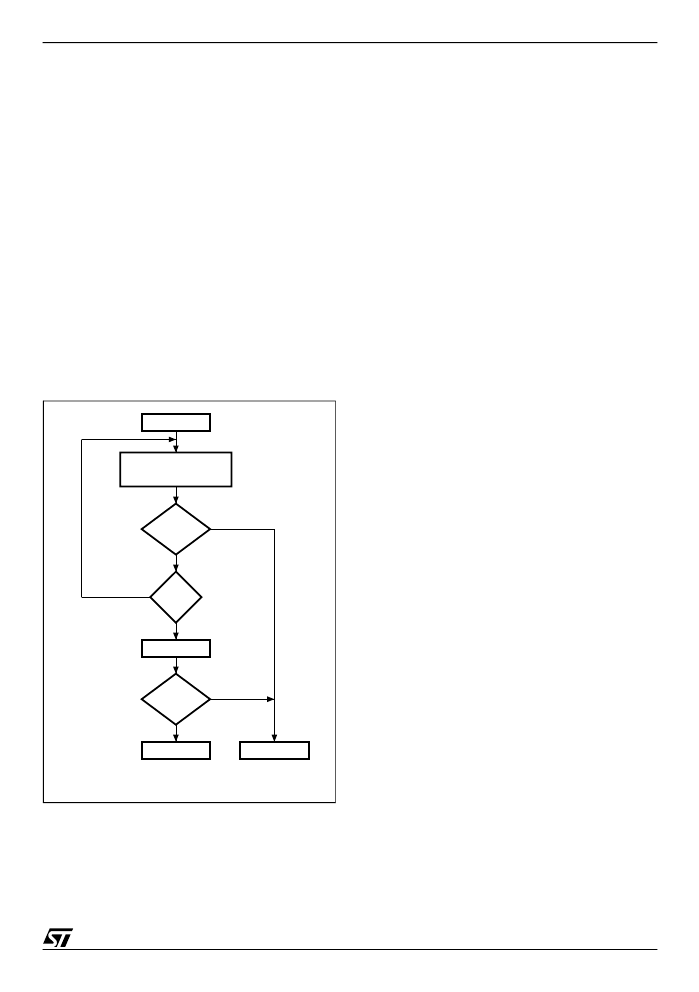- 您現(xiàn)在的位置:買賣IC網(wǎng) > PDF目錄370021 > PSD813F5V -60V 100kRad Hi-Rel Single P-Channel TID Hardened MOSFET in a SMD-2 package; Similar to IRHNA9064 with optional Total Dose Rating of 300kRads PDF資料下載
參數(shù)資料
| 型號: | PSD813F5V |
| 英文描述: | -60V 100kRad Hi-Rel Single P-Channel TID Hardened MOSFET in a SMD-2 package; Similar to IRHNA9064 with optional Total Dose Rating of 300kRads |
| 中文描述: | Flash在系統(tǒng)編程(ISP)外設(shè)的8位微控制器 |
| 文件頁數(shù): | 23/103頁 |
| 文件大?。?/td> | 1185K |
| 代理商: | PSD813F5V |
第1頁第2頁第3頁第4頁第5頁第6頁第7頁第8頁第9頁第10頁第11頁第12頁第13頁第14頁第15頁第16頁第17頁第18頁第19頁第20頁第21頁第22頁當(dāng)前第23頁第24頁第25頁第26頁第27頁第28頁第29頁第30頁第31頁第32頁第33頁第34頁第35頁第36頁第37頁第38頁第39頁第40頁第41頁第42頁第43頁第44頁第45頁第46頁第47頁第48頁第49頁第50頁第51頁第52頁第53頁第54頁第55頁第56頁第57頁第58頁第59頁第60頁第61頁第62頁第63頁第64頁第65頁第66頁第67頁第68頁第69頁第70頁第71頁第72頁第73頁第74頁第75頁第76頁第77頁第78頁第79頁第80頁第81頁第82頁第83頁第84頁第85頁第86頁第87頁第88頁第89頁第90頁第91頁第92頁第93頁第94頁第95頁第96頁第97頁第98頁第99頁第100頁第101頁第102頁第103頁

23/103
PSD81XFX, PSD83XF2, PSD85XF2
Data Toggle.
Checking the Toggle Flag (DQ6) bit
is a method of determining whether a Program or
Erase cycle is in progress or has completed. Fig-
ure 6 shows the Data Toggle algorithm.
When the MCU issues a Program instruction, the
embedded algorithm within the PSD8XXFX be-
gins. The MCU then reads the location of the byte
to be programmed in Flash memory to check sta-
tus. The Toggle Flag (DQ6) bit of this location tog-
gles each time the MCU reads this location until
the embedded algorithm is complete. The MCU
continues to read this location, checking the Tog-
gle Flag (DQ6) bit and monitoring the Error Flag
(DQ5) bit. When the Toggle Flag (DQ6) bit stops
toggling (two consecutive reads yield the same
value), and the Error Flag (DQ5) bit remains 0, the
embedded algorithm is complete. If the Error Flag
(DQ5) bit is 1, the MCU should test the Toggle
Flag (DQ6) bit again, since the Toggle Flag (DQ6)
bit may have changed simultaneously with the Er-
ror Flag (DQ5) bit (see Figure 6).
Figure 6. Data Toggle Flowchart
The Error Flag (DQ5) bit is set if either an internal
time-out occurred while the embedded algorithm
attempted to program the byte, or if the MCU at-
tempted to program a 1 to a bit that was not erased
(not erased is logic 0).
It is suggested (as with all Flash memories) to read
the location again after the embedded program-
ming algorithm has completed, to compare the
byte that was written to Flash memory with the
byte that was intended to be written.
When using the Data Toggle method after an
Erase cycle, Figure 6 still applies. the Toggle Flag
(DQ6) bit toggles until the Erase cycle is complete.
A 1 on the Error Flag (DQ5) bit indicates a time-out
condition on the Erase cycle; a 0 indicates no er-
ror. The MCU can read any location within the sec-
tor being erased to get the Toggle Flag (DQ6) bit
and the Error Flag (DQ5) bit.
PSDsoft Express generates ANSI C code func-
tions which implement these Data Toggling algo-
rithms.
Unlock Bypass (PSD833F2x, PSD834F2x,
PSD853F2x, PSD854F2x).
The Unlock Bypass
instructions allow the system to program bytes to
the Flash memories faster than using the standard
Program instruction. The Unlock Bypass mode is
entered by first initiating two Unlock cycles. This is
followed by a third WRITE cycle containing the Un-
lock Bypass code, 20h (as shown in Table 8).
The Flash memory then enters the Unlock Bypass
mode. A two-cycle Unlock Bypass Program in-
struction is all that is required to program in this
mode. The first cycle in this instruction contains
the Unlock Bypass Program code, A0h. The sec-
ond cycle contains the program address and data.
Additional data is programmed in the same man-
ner. These instructions dispense with the initial
two Unlock cycles required in the standard Pro-
gram instruction, resulting in faster total Flash
memory programming.
During the Unlock Bypass mode, only the Unlock
Bypass Program and Unlock Bypass Reset Flash
instructions are valid.
To exit the Unlock Bypass mode, the system must
issue the two-cycle Unlock Bypass Reset Flash in-
struction. The first cycle must contain the data
90h; the second cycle the data 00h. Addresses are
Don’t Care for both cycles. The Flash memory
then returns to READ Mode.
READ
DQ5 & DQ6
START
READ DQ6
FAIL
PASS
AI01370B
D=
TOGGLE
NO
NO
YES
YES
DQ5
= 1
NO
YES
D=
TOGGLE
相關(guān)PDF資料 |
PDF描述 |
|---|---|
| PSD86 | THREE PHASE RECTIFIER BRIDGE |
| PSF101 | WORLD MAGNETICS ULTRA SENSITIVEPRESSURESWITCHES |
| PSG61 | 4 KEY BI-BI CALL |
| PSM-100KPD | Pressure sensor module/Gauge,Differential |
| PSM-100KPDV | Pressure sensor module/Gauge,Differential |
相關(guān)代理商/技術(shù)參數(shù) |
參數(shù)描述 |
|---|---|
| PSD813F5VA-15J | 功能描述:SPLD - 簡單可編程邏輯器件 3.0V 1M 150ns RoHS:否 制造商:Texas Instruments 邏輯系列:TICPAL22V10Z 大電池?cái)?shù)量:10 最大工作頻率:66 MHz 延遲時(shí)間:25 ns 工作電源電壓:4.75 V to 5.25 V 電源電流:100 uA 最大工作溫度:+ 75 C 最小工作溫度:0 C 安裝風(fēng)格:Through Hole 封裝 / 箱體:DIP-24 |
| PSD813F5VA-15U | 功能描述:SPLD - 簡單可編程邏輯器件 U 511-PSD813F2VA-15U RoHS:否 制造商:Texas Instruments 邏輯系列:TICPAL22V10Z 大電池?cái)?shù)量:10 最大工作頻率:66 MHz 延遲時(shí)間:25 ns 工作電源電壓:4.75 V to 5.25 V 電源電流:100 uA 最大工作溫度:+ 75 C 最小工作溫度:0 C 安裝風(fēng)格:Through Hole 封裝 / 箱體:DIP-24 |
| PSD813FH-15J | 制造商:WSI 功能描述: |
| PSD813FH-90J | 制造商:WSI 功能描述: |
| PSD813FN-15J | 制造商:WSI 功能描述: |
發(fā)布緊急采購,3分鐘左右您將得到回復(fù)。